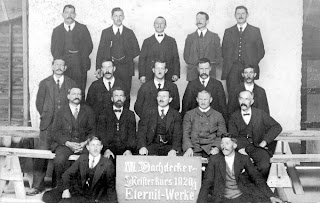Teraźniejszość, historia i przyszłość wsi Chromiec w Górach Izerskich, dawniej Ludwigsdorf i. Rsgb.
niedziela, 28 listopada 2010
sobota, 27 listopada 2010
Z cyklu: Znaleziska / from the Finds series: Eternit
Historia eternitu i (austriackiej) firmy Eternit tutaj: http://www.eternit.at/9935.0.html, a oddziału szwajcarskiego tutaj: http://www.eternit.ch/en/about-eternit/history.
Wynalazca eternitu, Ludwig Hatschek (czyli Ludwik Haczek, a raczej Haček):
"W roku 1920 przeprowadzono bezpłatne szkolenia dla łącznie 155 dekarzy. W efekcie liczba reklamacji spadła o 90 procent!" ((Eternitwerke AG, Niederurnen, Szwajcaria) (http://www.eternit.ch/en/about-eternit/history):
piątek, 26 listopada 2010
Z cyklu: Ślady / from the Traces series
Unglueckstaette
des
Ernst Daniel
veruengluckte am 3.
Januar 1900 beim
Holzfahren
"W tym miejscu
dnia 3 stycznia 1900
wioząc drewno
zginął nieszczęśliwie
Daniel Ernst"
Etykiety:
Antoniów,
Antoniwald,
Blumendorf,
Boża Góra,
Chromiec,
Gotthardsberg,
Kieferhauser,
Kwieciszowice,
Ledenhauser,
Ludwigsdorf,
Sosnka,
Steinhauser
Z cyklu: Znaleziska / from the Finds series
Kirasjerzy (z fran. cuirassier – pancerny) – rodzaj ciężkiej jazdy (szturmowej) w zbrojach z metalowych płyt (kirysach).
Jazda tego typu powstała w drugiej połowie XVI w. z przekształcenia w nią z ciężkozbrojnej jazdy kopijniczej, choć nowożytnych kirasjerów poprzedzali w starożytności macedońscy hetairoi o zbliżonym przeznaczeniu bojowym i rynsztunku co ich spadkobiercy.
Jednostka ta oznacza nowe stadium rozwoju europejskiej ciężkiej jazdy. Pancerz używany przez tych jeźdźców był znacznie lżejszy, zapewniając większą szybkość i zwinność. Znaczną uwagę poświęcano technikom jeździeckim. Kirasjerzy potrafili zadawać potężne, śmiercionośne uderzenia zarówno nieprzyjacielskiej konnicy, jak i piechocie.[http://pl.wikipedia.org/wiki/Kirasjerzy]
The utility of this armour was sometimes disputed. Prussian cuirassiers had abandoned the armoured cuirass before the Napoleonic Wars, but were reissued with it in 1814. During this period, British cavalry wore cuirasses only during the Netherlands campaign of 1794, using breastplates taken from store.[4] The Austrian cuirassiers traded protection for mobility by wearing only the half-cuirass (without back plate) and helmet[5]. Napoleon believed it sufficiently useful that he had cuirassier-style armour issued to his two carabinier regiments after the Battle of Wagram. Armies may have retained the cuirassier into the 19th century because of the psychological effect of armoured cavalry on the battlefield.
Cuirassiers were generally the senior branch of the mounted portion of an army, retaining their status as heavy cavalry—"big men on big horses". Their value as a heavy striking force during the Napoleonic Wars ensured that the French, Russian and Prussian armies continued to use cuirassier regiments throughout the nineteenth century. However the expense and inflexibility of this class of cavalry meant that it survived in other armies only in the form of Guard or other ceremonial units.[http://en.wikipedia.org/wiki/Cuirassier]
Generał von Marvitz zapisał kiedyś: "Ta formacja przełamie wszystko, co jej stanie na drodze. Połowa z nich padnie pod kulami wroga lub wpadnie w okopy, a setki skręcą sobie kark. Ale oni się nie zatrzymają (a co dopiero mówić o zawróceniu), ponieważ przy całym tym zamęcie i łoskocie powodowanym przez setki koni rwących w zwartym szyku nawet najlepszy jeździec nie byłby w stanie kierować swoim wierzchowcem - są po prostu skazani na to, by się przebić.A nawet jeśli któryś z nich okiełzna konia i odzyska panowanie nad nim, niech lepiej zapomni o zatrzymywaniu się, bo zostałby powalony i stratowany przez gnających za nim. Nie ma zatem cienia wątpliwości, że po rozpoczęciu szarży może się ona zakończyć wyłącznie przełamaniem linii wroga lub śmiercią całego oddziału".[http://pl.wikipedia.org/wiki/Kirasjerzy]
czwartek, 25 listopada 2010
Z cyklu: Znaleziska / From the Finds series
[17.05.2010]
Erich Friedrich Wilhelm Ludendorff (sometimes given incorrectly as von Ludendorff) (9 April 1865 – 20 December 1937) was a German military officer, victor of Liège, and, with Paul von Hindenburg, one of the victors of the battle of Tannenberg. From August 1916 his appointment as Generalquartiermeister made him joint head (with von Hindenburg) of Germany's war effort. From this point on he ran Germany's war effort in World War I until his resignation in October 1918.
[...]
After 1928, Ludendorff went into retirement, having fallen out with the Nazi party. He no longer approved of Hitler and began to regard him as just another manipulative politician, and perhaps worse. In his later years, Ludendorff went into a relative seclusion with his second wife, Mathilde von Kemnitz (1874–1966), writing several books and leading the Tannenbergbund. He concluded that the world's problems were the result of Christians (especially of the Jesuits and Catholicism), Jews, and Freemasons. Together with Mathilde, he founded the "Bund für Gotteserkenntnis" (Society for the Knowledge of God), a small and rather obscure esoterical society of Theists that survives to this day.
In an attempt to regain Ludendorff's favour, Hitler paid Ludendorff an unannounced visit in 1935 and offered to make him a Field Marshal[citation needed]. Infuriated, Ludendorff angrily replied, "a Field Marshal is born, not made". When Ludendorff died in Tutzing in 1937, he was given – against his explicit wishes, a state funeral attended by Hitler, who declined to speak. He was buried in the Neuer Friedhof in Tutzing.
wtorek, 23 listopada 2010
Subskrybuj:
Posty (Atom)
































